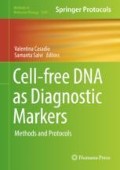Abstract
Digital PCR (dPCR) enables the detection and characterization of fragmented DNA that is in low abundance in blood. Here, we describe the comparative analysis of mutations in tumor tissue DNA and plasma cell-free DNA (cfDNA) using a dPCR method. Tumor cells are captured by laser microdissection to obtain only cancerous cells from a small quantity of metastatic tissue samples and to exclude inflammatory and stromal cells. We extracted cfDNA from 500 μL of plasma, which is sufficient for target mutation analysis using dPCR. The dPCR assay for the detection of the specific region in the target gene consists of a pair of primers and two probes labeled with a fluorescent dye capable to recognize the presence or absence of a specific mutation. Using the dPCR method, we can identify only a few mutations in tissue that are present also in plasma.
Access this chapter
Tax calculation will be finalised at checkout
Purchases are for personal use only
References
Diaz LA Jr, Bardelli A (2014) Liquid biopsies: genotyping circulating tumor DNA. J Clin Oncol 32:579–586
Dawson SJ, Tsui DW, Murtaza M et al (2013) Analysis of circulating tumor DNA to monitor metastatic breast cancer. N Engl J Med 368:1199–1209
Garcia-Murillas I, Schiavon G, Weigelt B et al (2015) Mutation tracking in circulating tumor DNA predicts relapse in early breast cancer. Sci Transl Med 7:302ra133
Diehl F, Schmidt K, Choti MA et al (2008) Circulating mutant DNA to assess tumor dynamics. Nat Med 14:985–990
Hindson BJ, Ness KD, Masquelier DA et al (2011) High-throughput droplet digital PCR system for absolute quantitation of DNA copy number. Anal Chem 83:8604–8610
Dressman D, Yan H, Traverso G et al (2003) Transforming single DNA molecules into fluorescent magnetic particles for detection and enumeration of genetic variations. Proc Natl Acad Sci U S A 100:8817–8822
Vogelstein B, Kinzler KW, Digital PCR (1999) Proc Natl Acad Sci U S A 96:9236–9241
Takeshita T, Yamamoto Y, Yamamoto-Ibusuki M et al (2015) Droplet digital polymerase chain reaction assay for screening of ESR1 mutations in 325 breast cancer specimens. Transl Res 166:540–553, e542
Takeshita T, Yamamoto Y, Yamamoto-Ibusuki M et al (2017) Comparison of ESR1 mutations in tumor tissue and matched plasma samples from metastatic breast cancer patients. Transl Oncol 10:766–771
Takeshita T, Yamamoto Y, Yamamoto-Ibusuki M et al (2017) Prevalence of ESR1 E380Q mutation in tumor tissue and plasma from Japanese breast cancer patients. BMC Cancer 17:786
Takeshita T, Yamamoto Y, Yamamoto-Ibusuki M et al (2017) Analysis of ESR1 and PIK3CA mutations in plasma cell-free DNA from ER-positive breast cancer patients. Oncotarget 8:52142–52155
Takeshita T, Yamamoto Y, Yamamoto-Ibusuki M et al (2018) Clinical significance of plasma cell-free DNA mutations in PIK3CA, AKT1, and ESR1 gene according to treatment lines in ER-positive breast cancer. Mol Cancer 17:67
Takeshita T, Yamamoto Y, Yamamoto-Ibusuki M et al (2016) Clinical significance of monitoring ESR1 mutations in circulating cell-free DNA in estrogen receptor positive breast cancer patients. Oncotarget 7:32504–32518
Acknowledgments
This work was supported in part by a grant-in-aid (project number 17K16511) for scientific research from the Ministry of Education, Science and Culture of Japan. The authors wish to thank Dr. Qui Shi, M.D., and Ms. Ikuko Suzu for their excellent technical support.
Author information
Authors and Affiliations
Corresponding author
Editor information
Editors and Affiliations
Rights and permissions
Copyright information
© 2019 Springer Science+Business Media, LLC, part of Springer Nature
About this protocol
Cite this protocol
Takeshita, T., Iwase, H. (2019). dPCR Mutational Analyses in Cell-Free DNA: A Comparison with Tissues. In: Casadio, V., Salvi, S. (eds) Cell-free DNA as Diagnostic Markers. Methods in Molecular Biology, vol 1909. Humana Press, New York, NY. https://doi.org/10.1007/978-1-4939-8973-7_8
Download citation
DOI: https://doi.org/10.1007/978-1-4939-8973-7_8
Published:
Publisher Name: Humana Press, New York, NY
Print ISBN: 978-1-4939-8972-0
Online ISBN: 978-1-4939-8973-7
eBook Packages: Springer Protocols

